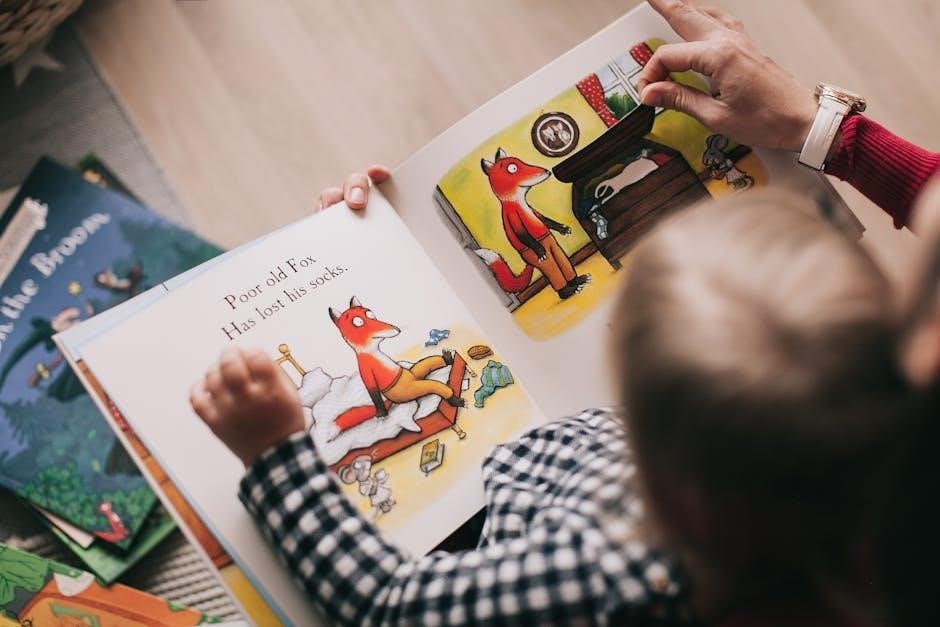Marillion’s iconic 1985 album Misplaced Childhood revitalized progressive rock with its emotional depth and intricate instrumentation. The guitar tab book offers detailed transcriptions, enabling musicians to master Steve Rothery’s complex techniques and solos, making it an essential resource for fans and guitarists alike.
1.1 Overview of Marillion and Their Album “Misplaced Childhood”
Marillion is a British progressive rock band formed in the early 1980s, known for their conceptual themes and intricate musicianship. Their third studio album, Misplaced Childhood, released in June 1985, marked a pivotal moment in their career. The album is a conceptual work exploring themes of personal struggle, introspection, and emotional growth, resonating deeply with listeners. It features a blend of melodic rock and progressive elements, showcasing the band’s ability to craft both complex compositions and accessible songs. Misplaced Childhood became a breakthrough success, reaching No. 1 in the UK Albums Chart and solidifying Marillion’s place in the prog rock revival of the 1980s. Its enduring appeal lies in its emotional depth and musical sophistication.
1.2 The Concept of a Guitar Tab Book for the Album
A guitar tab book for Misplaced Childhood provides a detailed, note-by-note transcription of Steve Rothery’s guitar work, allowing players to accurately recreate the album’s intricate solos and rhythms. This resource is invaluable for musicians seeking to understand and perform the album’s complex arrangements. By offering precise tablature, the book ensures that even the most nuanced techniques are accessible. It serves as both a learning tool and a tribute to Rothery’s mastery, enabling fans to delve deeper into the music they love. The tab book is a comprehensive guide, making it easier for guitarists to capture the essence of Misplaced Childhood and integrate its iconic riffs and melodies into their own playing.
1.3 Importance of Guitar Tabs for Musicians and Fans
Guitar tabs are a vital resource for musicians and fans, offering a clear, visual representation of music that transcends traditional notation. For Misplaced Childhood, tabs provide access to Steve Rothery’s intricate playing style, enabling precise replication of his work. Musicians benefit from the ability to study and perform complex pieces with accuracy, while fans gain a deeper connection to the music by playing it themselves. Tabs also serve as a learning tool, helping guitarists improve their skills and understand the album’s musical structure. This accessibility fosters a sense of community among players, encouraging collaboration and further exploration of Marillion’s legacy. Ultimately, guitar tabs bridge the gap between admiration and participation, making Misplaced Childhood a tangible and enduring part of guitar culture.

Background of “Misplaced Childhood”

Released in June 1985, Misplaced Childhood marked Marillion’s resurgence of progressive rock in a polished, modern format, captivating audiences with its emotional depth and intricate storytelling.
2.1 Release Date and Historical Context
Misplaced Childhood was released in June 1985, a pivotal moment for progressive rock. By then, the genre had waned in popularity, overshadowed by the rise of pop and new wave. Marillion emerged as a key act in revitalizing prog rock, blending intricate storytelling with accessible melodies. The album’s release coincided with a growing nostalgia for 1970s prog, yet it offered a fresh, modern take. Its success helped redefine the genre for a new generation, proving that progressive rock could evolve while retaining its complexity and depth. The album’s historical significance lies in its ability to bridge the gap between classic prog and contemporary music, making it a landmark release in the genre’s history.
2.2 Tracklist and Key Songs
Misplaced Childhood features a cohesive tracklist that tells a conceptual story, blending emotional depth with intricate instrumentation. The album includes tracks like “Pseudo Silk Kimono,” “The Mirror,” “Kayleigh,” “Lavender,” “Bitter Suite,” “Heart of Lothian,” and “Waterhole (Expresso Bongo).” “Kayleigh” stands out as a fan favorite and one of Marillion’s most recognizable songs, reaching number two on the UK Singles Chart. “Heart of Lothian” showcases the band’s ability to craft epic, atmospheric pieces with memorable guitar riffs. The album’s structure and tracklist reflect its conceptual nature, with each song contributing to the overall narrative and emotional journey. This carefully curated selection of tracks has cemented Misplaced Childhood as a landmark album in progressive rock history, offering both musical complexity and emotional resonance for listeners.
2.3 The Album’s Impact on Progressive Rock

Misplaced Childhood played a pivotal role in revitalizing progressive rock in the mid-1980s, a time when the genre was deemed outdated. Marillion’s innovative approach, blending intricate compositions with accessible melodies, inspired a new wave of prog bands. The album’s success challenged the dominance of mainstream rock, proving that conceptual, complex music could resonate with a wide audience. Its influence extended beyond the 1980s, shaping both neo-progressive and modern prog movements. The album’s emotional depth and musical sophistication set a benchmark, encouraging artists to explore storytelling and atmospheric soundscapes. Additionally, the guitar tab book has further cemented its legacy, allowing musicians to study and emulate Steve Rothery’s masterful techniques, ensuring the album’s impact endures in the world of progressive rock and beyond.

The Guitar Tab Book: Contents and Features

The guitar tab book features detailed transcriptions of all tracks from Misplaced Childhood, offering precise notation and insights into Steve Rothery’s techniques, essential for mastering the album’s intricate guitar work.
3.1 Detailed Breakdown of the Book’s Structure
The guitar tab book for Misplaced Childhood is meticulously organized, mirroring the album’s tracklist. Each song is presented with note-by-note transcriptions, capturing every nuance of Steve Rothery’s playing. The book begins with an introduction to the album’s context and significance, followed by detailed tabs for each track, including “Pseudo Silk Kimono,” “Kayleigh,” and “Lavender.” Additional sections provide chord charts, rhythm guitar parts, and solos, ensuring comprehensive coverage. The tabs are arranged in standard guitar tablature format, making them easy to follow for both experienced musicians and newcomers. The book also includes a glossary of terms and a discography, enhancing its educational and reference value. This structure ensures that players can explore the album’s intricate guitar work in a logical and accessible manner.
3.2 Accuracy and Completeness of the Tabs
The guitar tabs in the Misplaced Childhood book are renowned for their precision and thoroughness. Each transcription was meticulously crafted to reflect Steve Rothery’s original recordings, ensuring that every chord, riff, and solo is accurately represented. The tabs cover the entire album, including intricate instrumental passages and subtle nuances often overlooked in other transcriptions. This attention to detail allows musicians to replicate the album’s sound faithfully. The completeness of the tabs is further enhanced by the inclusion of rhythm parts, harmonics, and effects, providing a holistic learning experience. Fans and guitarists alike have praised the tabs for their fidelity to the original music, making them an indispensable resource for mastering Marillion’s iconic album.
3.4 Special Features for Guitarists
The Misplaced Childhood guitar tab book includes several special features tailored for guitarists. It offers detailed fingerboard diagrams, highlighting key positions and string bends, which are essential for capturing Steve Rothery’s distinctive playing style. Additionally, the book provides alternate tunings and capo placements used in the album, ensuring authenticity. Guitarists will appreciate the inclusion of tempo and time signature changes, as well as dynamic markings, which aid in replicating the album’s emotional depth. The tabs also feature annotations on effects usage, such as delay and reverb, crucial for achieving the album’s signature sound. These features make the book a comprehensive guide, catering to both intermediate and advanced players seeking to master Marillion’s progressive rock masterpiece.
Guitar Tabs for “Misplaced Childhood”: An Overview
The guitar tabs for Misplaced Childhood offer detailed transcriptions, capturing the album’s complexity. They serve as a valuable resource for musicians and fans, aiding in learning and appreciation.
4.1 What Are Guitar Tabs and How They Work
Guitar tabs, or tablature, are a simplified notation system for guitarists. They consist of six lines representing the instrument’s strings, with numbers indicating which frets to press. This format is easier to read than traditional sheet music, making it accessible for musicians of all skill levels. Tabs provide a visual guide to playing songs accurately, showing the exact positions for chords, melodies, and solos. For complex albums like Misplaced Childhood, tabs are invaluable, as they break down intricate pieces into manageable parts. They allow learners to focus on technique and expression, ensuring that even challenging songs become approachable. This system has become a cornerstone for modern guitar education and collaboration among musicians.
4.2 The Role of Tabs in Learning Complex Songs
Guitar tabs play a crucial role in mastering complex songs like those on Misplaced Childhood. They simplify intricate compositions by breaking them into manageable sections, allowing guitarists to focus on specific techniques. Tabs provide a clear visual guide, making it easier to navigate layered arrangements, solos, and unconventional tunings. For songs with complex time signatures or multiple guitar parts, tabs offer a structured approach, ensuring accuracy. They enable musicians to identify challenging sections and practice them effectively. This systematic learning process helps build confidence and skill, especially for those tackling progressive rock’s intricate compositions. By offering a detailed roadmap, tabs make even the most complex songs accessible, fostering a deeper connection with the music and enhancing overall musicianship.
4.3 Popular Songs from the Album in Tab Format
The guitar tab book for Misplaced Childhood includes detailed transcriptions of its most iconic tracks, such as “Kayleigh” and “Lavender.” These songs, known for their intricate melodies and emotional depth, are now accessible to guitarists of all levels. The tabs capture the essence of Steve Rothery’s playing style, from soaring solos to delicate arpeggios. Musicians can explore the album’s layered arrangements and complex guitar parts with precision. The tab book also highlights the album’s progressive elements, offering a clear guide to its intricate time signatures and multiple guitar layers. This resource is invaluable for fans and guitarists seeking to master Marillion’s timeless compositions, ensuring their music remains alive and playable for future generations. The tabs provide a bridge between the album’s complexity and the guitarist’s ability to replicate its magic.
Guitar Techniques in “Misplaced Childhood”

Steve Rothery’s guitar techniques in Misplaced Childhood are renowned for their emotional depth and complexity. The tab book provides a detailed guide to mastering his arpeggios, solos, and layered arrangements, essential for guitarists aiming to replicate his iconic style accurately.
5.1 Steve Rothery’s Guitar Style and Influence
Steve Rothery’s guitar style in Misplaced Childhood is a cornerstone of the album’s sound, blending intricate arpeggios, emotive solos, and atmospheric textures. His playing is deeply expressive, often serving as an extension of the album’s narrative. Rothery’s use of effects pedals and nuanced phrasing creates a rich, layered sound that has become iconic in progressive rock. His influence extends beyond Marillion, inspiring countless guitarists with his ability to balance technical complexity with emotional depth. The tab book provides a detailed roadmap for mastering his techniques, offering insights into his approach to melody and arrangement. Rothery’s work on Misplaced Childhood remains a benchmark for guitarists seeking to explore progressive rock’s possibilities.
- Emotive and intricate guitar solos.
- Use of arpeggios and atmospheric textures.
- Influence on modern progressive rock guitarists.
5.2 Key Techniques Used in the Album
Steve Rothery’s work on Misplaced Childhood showcases a variety of advanced guitar techniques that define the album’s sound. Prominent among these are intricate arpeggio patterns, which add a classical elegance to tracks like “Kayleigh.” Rothery also employs string skipping and legato playing to create fluid, intricate solos, as heard in “Lavender.” His use of atmospheric effects, such as delay and reverb, enhances the album’s emotional depth, particularly in “The Space” and “Blind Curve.” Additionally, Rothery’s ability to blend melodic phrasing with complex rhythms underscores the album’s progressive nature. These techniques, meticulously transcribed in the tab book, provide guitarists with a comprehensive guide to mastering the album’s signature sound.
- Arpeggio patterns for melodic complexity.
- String skipping and legato playing for fluid solos.
- Atmospheric effects to enhance emotional depth.
5.3 How to Master the Techniques Using the Tab Book
To master Steve Rothery’s techniques from Misplaced Childhood, the tab book provides a detailed roadmap. Start by thoroughly understanding the tablature notation, ensuring accuracy in finger placement and string selection. Practice slowly with a metronome to build precision and control, especially in intricate arpeggio sections. Isolate challenging passages, such as the solo in “Kayleigh,” and focus on replicating Rothery’s phrasing and vibrato. Play along with the album to capture the timing and emotional nuances. Analyze Rothery’s use of effects like delay and reverb, and experiment with similar settings to enhance your sound. Consistent practice and attention to detail will help you embody the album’s signature guitar work.
- Start with slow, precise practice using a metronome.
- Isolate and master challenging sections like solos.
- Play along with the album for timing and feel.
- Experiment with effects to replicate Rothery’s sound.


Resources for Learning and Playing
The guitar tab book for Misplaced Childhood is an essential resource for learning the album’s intricate guitar parts. Online forums and video tutorials also provide valuable support for musicians mastering Steve Rothery’s techniques.
6.1 Recommended Tools for Practicing
To effectively practice the guitar parts from Misplaced Childhood, musicians should use a high-quality electric guitar, preferably with versatile pickups to capture the album’s dynamic range. A reliable amplifier with clean and overdrive channels is essential for replicating Steve Rothery’s tones. Effects pedals, such as reverb and delay, are crucial for achieving the album’s atmospheric soundscapes. A metronome will help in mastering the intricate time signatures and rhythms, while a guitar tuner ensures precision. Additionally, a digital audio workstation (DAW) or software like Guitar Pro can aid in breaking down and analyzing the tablature. Finally, a looper pedal can assist in practicing complex sections repeatedly. These tools collectively provide a comprehensive setup for musicians aiming to faithfully interpret the album’s iconic guitar work.
6.2 Online Communities and Forums for Support
Online communities and forums are invaluable for musicians seeking support while learning from the Misplaced Childhood guitar tab book. Platforms like Reddit, with subreddits such as r/Guitar and r/ProgRock, offer spaces for discussion, tips, and shared experiences. Facebook groups dedicated to Marillion or progressive rock also provide a sense of camaraderie and resource sharing. Specialized music forums, such as Ultimate-Guitar or GuitarWorld, often feature threads where fans and musicians discuss the album and its tabs. These communities allow users to ask questions, share progress, and gain insights from others who have mastered the material. Additionally, they often host collaborative projects or challenges, fostering motivation and improvement. Engaging with these forums can enhance the learning process and deepen appreciation for the album’s intricate guitar work.
6.3 Video Tutorials and Lessons
Video tutorials and lessons are a powerful resource for musicians aiming to master the guitar parts from Misplaced Childhood. Platforms like YouTube and specialized guitar websites host a wealth of instructional content, breaking down complex songs into manageable sections. These tutorials often align with the tab book, providing visual and auditory guidance for intricate solos and rhythms. Many lessons focus on Steve Rothery’s distinctive playing style, offering insights into his techniques and how to replicate them. Additionally, video tutorials can help musicians understand timing, phrasing, and the emotional expression required for the album’s tracks. They are particularly useful for visual learners, as they demonstrate finger placement, string bending, and other essential skills. By combining video lessons with the tab book, guitarists can achieve a deeper understanding and more accurate performance of Marillion’s iconic music.
The Legacy of “Misplaced Childhood”
Misplaced Childhood remains a cornerstone of progressive rock, inspiring generations of musicians. Its guitar tab book ensures the album’s timeless appeal, preserving Steve Rothery’s iconic riffs for future guitarists.
7.1 The Album’s Influence on Modern Prog Rock
Misplaced Childhood played a pivotal role in revitalizing progressive rock in the 1980s, offering a fresh, accessible take on the genre. Its emotional depth and intricate arrangements inspired a new wave of prog bands, blending complex structures with melodic sensibility. The album’s success proved that prog rock could evolve while staying true to its roots, influencing modern acts to experiment with storytelling and atmospheric soundscapes. Its legacy is evident in contemporary prog bands that emulate its balance of technicality and emotional resonance. The guitar tab book further cements this influence, allowing musicians to study and adapt Steve Rothery’s iconic riffs and solos, ensuring the album’s techniques remain relevant in modern guitar culture.
7.2 Fan Reactions and Reviews Over the Years
Fans of Misplaced Childhood have consistently praised the album for its emotional depth and musical complexity. Many consider it a landmark in progressive rock, with its conceptual themes and soaring melodies resonating deeply. The guitar tab book has further enhanced fan engagement, allowing enthusiasts to explore the album’s intricate instrumentation. Reviews highlight the tab book’s accuracy and attention to detail, making it a cherished resource for musicians. Over the years, the album has maintained a loyal fan base, with many crediting it as a formative influence in their musical journeys. The tab book has also sparked online discussions, fostering a sense of community among fans and guitarists. Its enduring popularity underscores the album’s timeless appeal and its continued relevance in modern music culture.
7.3 The Enduring Appeal of the Guitar Tab Book
The guitar tab book for Misplaced Childhood remains a vital resource for musicians, offering precise transcriptions of Steve Rothery’s masterful guitar work. Its enduring appeal lies in its ability to bridge generations, allowing both seasoned players and newcomers to explore the album’s intricate compositions. The book’s detailed breakdown of solos, riffs, and chord progressions ensures that Rothery’s unique style is accessible to learners. Additionally, the tab book has become a collector’s item for fans, symbolizing a connection to the album’s legacy. Its continued popularity highlights the timeless nature of Misplaced Childhood and its significance in guitar culture. As progressive rock evolves, the tab book stands as a testament to the album’s influence, ensuring its music remains alive and relevant for future generations of musicians and enthusiasts alike.

Conclusion
Misplaced Childhood and its guitar tab book remain timeless, offering musicians a gateway to master Steve Rothery’s iconic riffs and solos, ensuring the album’s enduring legacy in progressive rock.
8.1 Final Thoughts on the Album and Tab Book
Misplaced Childhood stands as a landmark in progressive rock, blending emotional storytelling with intricate instrumentation. The guitar tab book is a testament to its enduring influence, offering precise transcriptions that allow musicians to delve into Steve Rothery’s masterful playing. For fans and guitarists alike, this resource bridges the gap between admiration and emulation, ensuring the album’s legacy endures. By providing a detailed roadmap to its iconic riffs and solos, the tab book not only honors the album’s artistry but also inspires future generations to explore its musical depth. It serves as a celebration of Misplaced Childhood‘s timeless appeal and its continued relevance in modern guitar culture.
8.2 Encouragement for Musicians to Explore the Tabs
Musicians seeking to expand their skills and deepen their connection with progressive rock should embrace the Misplaced Childhood guitar tab book. It offers a gateway to mastering Steve Rothery’s intricate techniques, from soaring solos to layered textures. By exploring these tabs, guitarists can gain insights into the album’s emotional depth and technical brilliance. Whether you’re a seasoned player or an aspiring one, this resource provides a comprehensive guide to recreating the album’s iconic sounds. It not only enhances your musicianship but also fosters a greater appreciation for the artistry behind Misplaced Childhood. Dive into the tabs and unlock the album’s musical richness, inspiring your own creative journey and connection to this prog rock masterpiece.
8.3 The Future of “Misplaced Childhood” in Guitar Culture
Misplaced Childhood remains a cornerstone of guitar culture, with its tab book ensuring its timeless appeal. As new generations of musicians discover the album, the detailed tabs provide a bridge to understanding its intricate compositions. The book’s accuracy and completeness make it a vital tool for both study and inspiration. By preserving Steve Rothery’s techniques, the tab book guarantees that the album’s influence will endure. It will continue to inspire guitarists to explore progressive rock’s boundaries, fostering a legacy of innovation and artistry. The future of Misplaced Childhood in guitar culture is bright, as its tabs keep its music alive and relevant for years to come.

